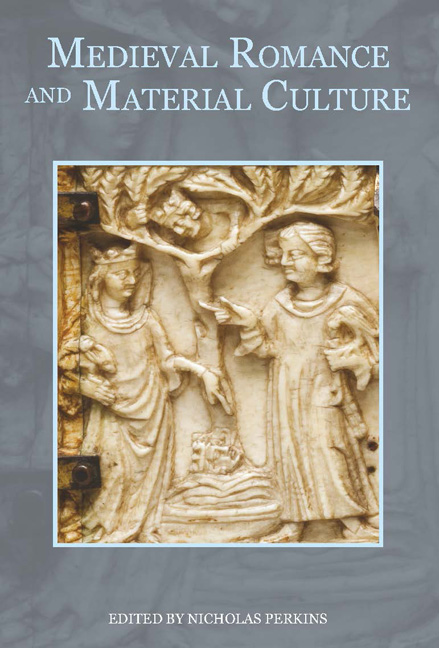Book contents
- Frontmatter
- Contents
- List of Illustrations
- List of Contributors
- Acknowledgements
- Abbreviations
- 1 Introduction: The Materiality of Medieval Romance and The Erle of Tolous
- 2 Courtly Culture and Emotional Intelligence in the Romance of Horn
- 3 Emplaced Reading, or Towards a Spatial Hermeneutic for Medieval Romance
- 4 Devotional Objects, Saracen Spaces and Miracles in Two Matter of France Romances
- 5 The Werewolf of Wicklow: Shapeshifting and Colonial Identity in the Lai de Melion
- 6 ‘Ladyes war at thare avowing’: The Female Gaze in Late-Medieval Scottish Romance
- 7 The Evolution of Cooperation in The Avowyng of Arthur
- 8 Ritual, Revenge and the Politics of Chess in Medieval Romance
- 9 Adventures in the Bob-and-Wheel Tradition: Narratives and Manuscripts
- 10 Reading King Robert of Sicily's Text(s) and Manuscript Context(s)
- 11 The Circulation of Romances from England in Late-Medieval Ireland
- 12 The Image of the Knightly Harper: Symbolism and Resonance
- 13 Carving the Folie Tristan: Ivory Caskets as Material Evidence of Textual History
- 14 Romancing the Orient: The Roman d'Alexandre and Marco Polo's Livre du grand Khan in Oxford, Bodleian Library MS Bodl. 264
- 15 The Victorian Afterlife of The Thornton Romances
- Index
13 - Carving the Folie Tristan: Ivory Caskets as Material Evidence of Textual History
Published online by Cambridge University Press: 05 May 2015
- Frontmatter
- Contents
- List of Illustrations
- List of Contributors
- Acknowledgements
- Abbreviations
- 1 Introduction: The Materiality of Medieval Romance and The Erle of Tolous
- 2 Courtly Culture and Emotional Intelligence in the Romance of Horn
- 3 Emplaced Reading, or Towards a Spatial Hermeneutic for Medieval Romance
- 4 Devotional Objects, Saracen Spaces and Miracles in Two Matter of France Romances
- 5 The Werewolf of Wicklow: Shapeshifting and Colonial Identity in the Lai de Melion
- 6 ‘Ladyes war at thare avowing’: The Female Gaze in Late-Medieval Scottish Romance
- 7 The Evolution of Cooperation in The Avowyng of Arthur
- 8 Ritual, Revenge and the Politics of Chess in Medieval Romance
- 9 Adventures in the Bob-and-Wheel Tradition: Narratives and Manuscripts
- 10 Reading King Robert of Sicily's Text(s) and Manuscript Context(s)
- 11 The Circulation of Romances from England in Late-Medieval Ireland
- 12 The Image of the Knightly Harper: Symbolism and Resonance
- 13 Carving the Folie Tristan: Ivory Caskets as Material Evidence of Textual History
- 14 Romancing the Orient: The Roman d'Alexandre and Marco Polo's Livre du grand Khan in Oxford, Bodleian Library MS Bodl. 264
- 15 The Victorian Afterlife of The Thornton Romances
- Index
Summary
Secular carved ivories complement manuscripts in so far as they too testify to the overall ‘life’ of stories in the Middle Ages. In particular, the close connection between ivories and romance has been widely discussed. Nonetheless, the relationship between word and image remains opaque. Even if an ivory can be clearly associated with a specific story, there is still the epistemological problem that the modern viewer is dependent on its written transmission in order to identify the story. The medieval viewer, by contrast, may have known variants of the story (circulating in written or oral form) that are now lost—and the same goes for the person who conceived the original scene (or scenes). While this person may have started out from a verbal manifestation of the story, the ivory is a unique and individual articulation, in its choice of episodes, style of depiction and, sometimes, combinations with scenes from other stories. However, just as the narratives contained in individual manuscripts may either be read on their own terms or as representatives of a wider textual version, so pictorial narratives—for all their specific, individual features—may also be understood to represent a particular version of the story (defined as a sub-group of variants linked by their similarity).
The premise that ivory caskets may be viewed on a par with manuscript texts as manifestations of a particular version of a story has the advantage of encouraging a combined assessment of the material evidence provided by related written and pictorial narratives, whilst still allowing for the fundamental differences between text and image as media. This article will seek to demonstrate the fruitfulness of this approach by considering the relationship between the Folies Tristan and two fourteenth-century ivory caskets depicting Tristan as a fool. The first of these caskets is now in the Musée de Cluny— Musée national du Moyen Âge—in Paris; the second is in the State Hermitage Museum, St Petersburg. Neither has yet received much scholarly attention.
- Type
- Chapter
- Information
- Medieval Romance and Material Culture , pp. 215 - 232Publisher: Boydell & BrewerPrint publication year: 2015



